by Romina Ciulli & Carole Dazzi
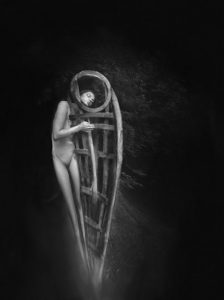
Sometimes a photograph taken with naturalness is enough to show the hidden side of reality or emotions, where the images, even if not very defined, appear incredibly sharp and engaging. This is what happens with the pinhole photography, one of the first techniques used in the photography, which doesn’t use lenses or objectives but, through a small pinhole, it generates images where gaze regains possession of a sensory tale that is extraordinary every time. The American photographer Sharon Harris uses this technique, and her photographs depict ethereal, sensual female figures, captured in surreal atmospheres and eccentric attitudes.
They tell about fascinating and disorienting inner worlds, where the observer gradually lets himself be transported. Her works include Industrial Series, The Wisdom of the Saint, Un-Traveling, Local Hunt, Nudes. Let’s talk with the artist.
Pinhole photography is a so-called “artisanal” technique, with longer exposure times than usual, slower creation processes and almost “sensorial” images, which provoke deep reflections and intense emotions in the observer. Can you tell us why you chose this technique and how you make your cameras?
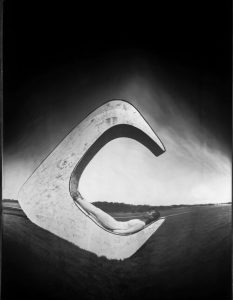
It still feels miraculous to have found pinhole photography. At the time I began exploring the art of pinhole photography, I had been pursuing printmaking as a medium. I delved into this photographic process in hopes that new printmaking ideas would emerge. But the charm of a pinhole photograph and the novel aspects of this art form lured me. I discovered that the slow, labor-intense, contemplative process of pinhole photography resonated with my artistic temperament. There is a natural flow that comes while working with a pinhole camera. Creating an image through the pinhole encourages one to anticipate the unexpected, a well that never seems to run dry. At times it can feel as though these photographs have been given to me as gifts. All of my cameras have been created using tin containers of various sizes and shapes. I drill the pinhole using the same sewing needle I have used since the creation of my first camera. To cut down on reflecting surfaces, I spray the inside of the tin flat black. Camera mounts are then epoxied to the tin allowing for the use of my tripod. I find the making of pinhole cameras to be easy and enjoyable. It’s always exciting to anticipate the unique image formation that a new camera will capture. I do find relief in the fact that there are no viewfinders in my pinhole cameras. There is a sense that these images are being “conjured” rather than “created”.
Your photographs represent dreamlike and evocative environments, populated by solitary female figures, often combined with majestic structures and distorted objects, which recall not just surreal dimensions, but mostly unconscious ones. How much does pinhole photography allow you to visually tell introspective aspects and unusual stories? And, if so, what is its limit?
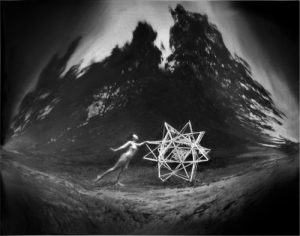
The art of pinhole photography allows me to tell introspective stories in all their entirety. The unpredictable and melodramatic nature of this art form often distorts reality and a fictionalized version of a scene evolves. An exposure taken midday can appear as though it had been taken at night. The capture of light shifts and a mysterious image begins to form. Clear pictorial boundaries are set through distortion or through the darkened edges of an image. The viewer becomes aware that the scene does not extend beyond the frame. Closing the door to the outside world, these photographic vignettes become self-contained scenarios. Photographing through the pinhole, with its quiet, inward way of revealing a subject speaks not only to my aesthetic, but, also to my introverted self.
Another feature of this technique is distortion. In your works this aspect seems to be associated with symbolic, imaginative or, better said, mythological elements. What is this aesthetic research linked to?
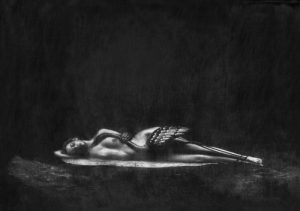
In much the same way that an artist draws, I too have the desire to shape an image. Distorted images resist predictability and tend to have a lingering effect on the viewer. I have found this to be true regarding an especially memorable image from “Alice in Wonderland”. In this scene, Alice is portrayed with a long, distorted neck. Despite the many years that have passed since I first laid eyes on this image, its visual impact still speaks volumes.
Your every creative process involves a careful technical planning and meticulous scenic construction. Also, in your shots you seem to re-create a world that is already conceptually delineated, yet managing to capture unpredictable aspects. How are your compositions born?
With the intention of pre-visualizing possibilities, I will sometimes visit a location prior to a photo shoot. I investigate angles, lighting, and the placement of the figure within the space. To further consider poses and compositional ideas, I sometimes study these preliminary images in photoshop. Within this program I am able to maneuver figures to better clarify my focus. That being said, and despite all good intentions, the making of a successful pinhole photograph often feels intangible, fragile, and elusive. Each composition is created with the knowledge that photographing through the pinhole is always a collaborative effort between the cameras, the model, the elements, and myself.
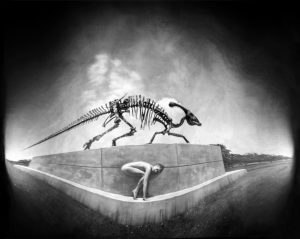
Recently my research to locate area sculptures revealed a nearby sculpture of a dinosaur skeleton adorned with jewels. I thought about how to portray the figure in relation to this very large structure. I investigated the model lying, standing, and curled directly under the dinosaur sculpture. I imagined the flip side of this scene, that is, the dinosaur bones below the surface and the model above. The fact that the figure would appear below the dinosaur skeleton, led to the idea that she could be emerging into the realm of the dinosaurs. Visually, this kind of pose would also take up needed space between the figure and the dinosaur.
Often in your photographic series, such as Industrial Series, The Wisdom of the Saint, Un-Traveling and others, we can see the continuous repeating of ancestral and tragic elements. On one hand the human figures seem to possess a symbolic /symbiotic link with the objects, animals or other structures in the image, on the other hand they manifest the desire to free themselves from such rooted references. What is the meaning you want to communicate?
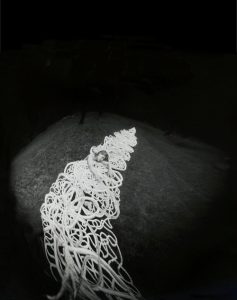
My images revolve around the female figure captured in environments which evoke a sense of otherworldliness. The desire to be free or to be rooted has a lot to do with the tension I seek to portray within these images. A push and pull both visually and emotionally. The quest for an image includes both pictorial considerations and narrative ones which will hopefully merge to form a conceptual image. Each image represents a private reality, an isolated space where the figure co-exists with the subject. The transforming of the ordinary into the extraordinary is a constant theme that runs through each body of work. It is about the eccentricities found in everyday life. It is about the familiar becoming unfamiliar.
In your shots, surrealism is a central aspect, able to highlight that mythological subtext typical of your aesthetic. The viewer unwittingly witnesses a voyeuristic staging, a tragic theatricality and a cinematic narrative. How much do other artistic practices affect your compositions?
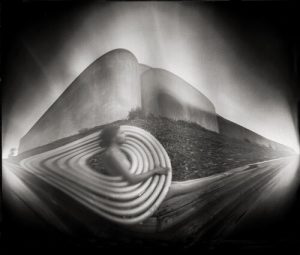
One of the most profound and helpful statements I have read regarding creativity came from the book Growing Up Creative by Teresa M. Amabile. The statement reads something to the effect of “The longer you stay in the maze the more creative the outcome.” Whether I am working in the garden or refining my surroundings, I do make a regular practice of “staying in the maze”. I am highly focused on the editing process and fortunate to have many artistic people in my life with whom I can collaborate on a regular basis. I make it a practice to visit museums and galleries often. I also follow numerous blogs for inspiration and the exploration of new ideas.
Are there any photographers or artists who have influenced your artistic path or continue to inspire you?
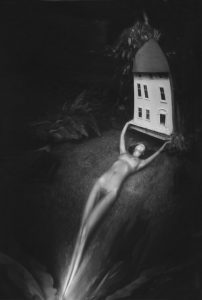
As a child, and to this day I remain enchanted by the painting, “ Death on a Pale Horse” by Albert Pinkham Ryder. In this painting a skeleton riding a horse around a racetrack seems unaware of a snake emerging from the ground. This painting checks all the boxes regarding composition, design, symbolism, imagination and tragedy. However, there is also beauty and light within it. I am also captivated by Dieter Appelt’s photograph “Canyon a Oppedette.” This photograph illuminates the qualities I also seek in my own work. A man standing high in a cave with his arms stretched out over airplane wings appears ready to depart. The stark white wings against the textured cave and the man’s soldierlike pose contrast the distant soft forest. Although we may be aware that this scene has been staged, we can still entertain the notion that we could have “happened upon the scene” and our imagination can take flight. I find photographer Andrea Kiss and artist Giorgio Morandi’s minimalistic approach and constant exploration of a particular theme to be inspiring. I am truly in awe of photographers Arther Tress, Eikoh Hosoe, Barbara Ess, and Ruth Thorne Thomsen.
Can you tell us about your future projects?
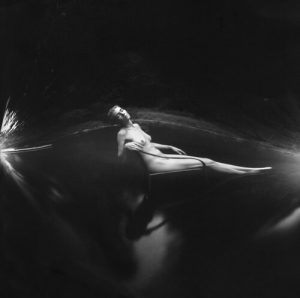
I have recently discovered a photographic mural featuring children wearing crowns that I wish to photograph. This mural, located interestingly enough, across the street from where my father taught high school, has caught my interest and, maybe during the photo shoot, my father will be there in spirit. I do plan on seeking other murals to work with since they can offer an opportunity to present in a surreal way. I have also been working with a large head sculpture in hopes that this may lead to a statuary series. I have set a goal for myself: to produce one hundred solid images. As I draw nearer to my goal, the publication of a book highlighting my pinhole photographs is starting to come into focus.
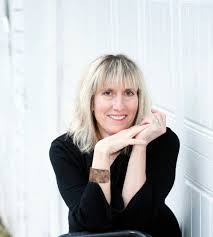
http://sharonharrisphotography.com/
@sharonharrisphinolephotography